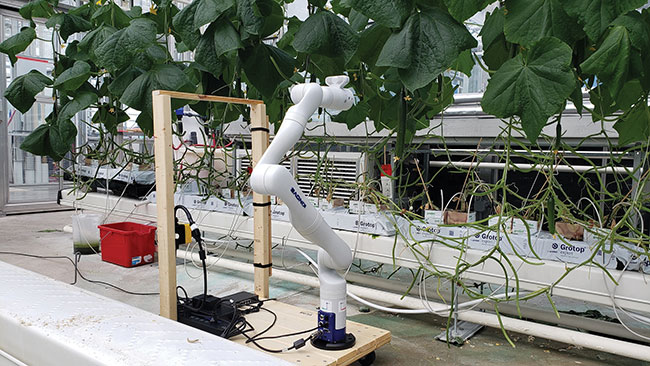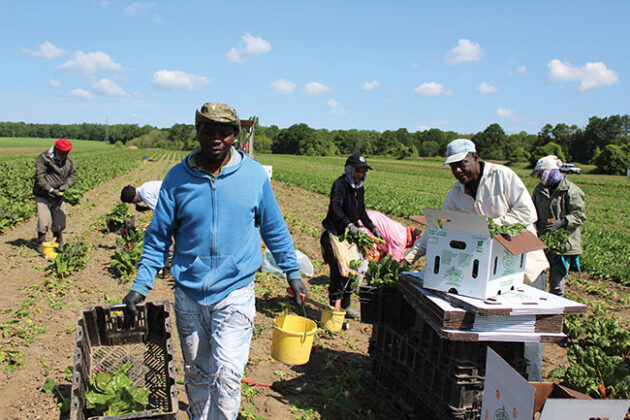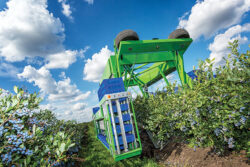
Features
Technology
Tech adoption depends on faith
Building relationships and trust among all of the stakeholders of the innovation value-chain and commercializing technology that really aligns with the reality of farming are key.
February 7, 2024 By Donna Fleury
 A prototype of the automated cucumber harvester created by Vineland Research and Innovation Centre.
Photo courtesy of Vineland Research and Innovation Centre.
A prototype of the automated cucumber harvester created by Vineland Research and Innovation Centre.
Photo courtesy of Vineland Research and Innovation Centre. Accelerating agriculture technology transfer and adoption and removing barriers and exploiting opportunities are priorities for the ag tech innovation sector. Researchers at Brock University’s Niagara Community Observatory (NCO) recently completed a multi-phase project to understand both the barriers that constrain and the drivers that promote ag tech adoption and the pursuit of globally competitive production systems.
“We recently released the final project policy report, Recommendations for Accelerating the Adoption of Automation and Robotics Technology in Ontario’s Agriculture Sector, which includes key findings and several recommendations,” explains Amy Lemay, NCO Research Fellow and Adjunct Professor in the Environmental Sustainability Research Centre at Brock University. “With funding through the Ontario Ministry of Agriculture, Food and Rural Affairs and Canadian Agricultural Partnership, the goal of the two-year study was to determine how to inform future policy around technology adoption and the barriers and drivers to accelerating technology transfer and adoption for automation and robotics. The study had several phases including surveys, case studies, interviews, focus groups and a literature review with multi-stakeholders such as farmers, researchers, technology developers, manufacturers, intermediaries and government officials from Ontario and across Canada.”
There are three key themes that emerged overall from the analysis of all phases of the project. Several of the themes are across the board and not just in the Ontario region. The first theme is the role of government in adapting and developing new policies and programs for supporting technology adoption. Although the focus of the project was on accelerating the adoption of automation and robotics technology, the findings clearly showed that there needs to be a broader concept of innovation, which shouldn’t be just about insisting farmers adopt the latest in emerging technology. There are many strategies farmers look to for innovation, and they need the choice to adopt what makes the most sense for their operation in terms of competitiveness, economics and sustainability.
“Farmers make very strategic business decisions for their operations including around innovation,” says Lemay. “The study clearly shows farmers are willing to try new things, but the decision is based on multiple factors. New innovations could include strategic decisions beyond just adopting a new digital or automation technology, such as new markets or marketing strategies, introduction of new crops or harvesting techniques and other innovations that improve overall competitiveness and financial stability. Therefore, broadening and redesigning cost-share and other incentive programs to fully reflect all forms of innovation is recommended. Understanding the realities of how long some of these technologies take to develop, commercialize and adopt must also be reflected in agriculture industry programs and policies as they are designed and delivered.”
The second theme reflected the need for an improved agriculture innovation system. This includes building better connections among all stakeholders across the innovation value-chain and making interactions more effective and productive. “We heard from farmers that tech solutions providers are often ‘solutions looking for a problem’,” notes Lemay. “The tech providers are not really engaging with the farm community or sector at a level that allows them to develop technology that really aligns with the reality of farming. Although there seems to be a romantic notion of what agriculture and farming is, the reality is farming can be messy, dirty, smelly, weather driven and hard work. On the other side, many of the tech developers we talked to tended to blame farmers for not adopting technology, even though it had not yet been validated or proven. They are expecting farmers to take the risk for validating and proving technology. Farmers are not risk averse, they are experienced business owners who make very strategic business decisions that have to work and provide a return on investment (ROI) for their operation.”

One major problem agricultural automation and robotics seeks to mitigate is the need for human labour. The COVID-19 pandemic highlighted the instability of programs like the Seasonal Agricultural Worker Program (SAWP) that rely on labourers from other countries. Photo courtesy of Pfenning’s Organic Farm.
“From the interviews, we heard that ROI for farmers is very complex and goes beyond a spreadsheet or accounting approach,” adds Lemay. “Farmers factor in a multitude of factors, including other social, environmental and quality of life factors into the equation. We are expecting a lot from the agriculture industry beyond providing a steady supply of nutritious food to include protecting the environment and being an engine of the economy, at the same time as generating their own livelihoods. Increasingly farmers are trying to address challenges that blur the lines between the private sector and the public good. The agriculture sector may be a solution to many of the societal challenges, but it will take a broader approach and support to help address these challenges and mitigate risk in agriculture.”
Therefore, building relationships and trust among all of the stakeholders throughout the innovation value-chain, starting right from the beginning of the development process is critical to support tech adoption by farmers. Trust and collaboration are key to adopting an industry development model that includes building relationships with farmers. Researchers recommend embracing an end-user development or co-creation model of technology adoption to strengthen connections between researchers, technology developers/solution providers and the sector across the agriculture innovation value-chain. The need for coordinating policies and programs across all levels of government and establishing regional agriculture innovation systems was also recognized.

Finefield’s autonomous Harvy 500 harvester was designed for blueberries and prevents ground-drop.
Photo courtesy of Finefield.
“A third theme acknowledges that the agriculture sector must do a better job of knowledge translation and transfer to accelerate adoption,” explains Lemay. “Our study showed that farmers, technology developers, and researchers wish to see closer links between provincial and national networks of agriculture intermediaries, who share and disseminate information, to fully leverage the full resources and expertise available across Canada. This points to the role of purpose-driven intermediaries in building relationships and trust, bringing researchers and tech developers together with farmers early on and improving farmers’ awareness of research and technology development resources available. The recognition that, over the past several decades, public advisory service capacity has been significantly scaled back, industry associations, applied research organizations and private companies are often relied on to be intermediaries. However, intermediaries need adequate personnel, technical competence and better financial resources to undertake more outreach activities to connect the technology community and farmers.”
There also needs to be an emphasis on making resources available that provide farmers with one-on-one technical support they need to navigate the complexities of tech adoption. Lemay adds that farmers making a decision about adopting new technology do not make a decision based on a single research project, they need to have access to cumulative results and findings to help validate recommendations. Intermediaries could pull together results of multiple studies and share those findings with farmers, so they have a basis to make a decision. Mobilizing industry associations to support this value-added knowledge transfer along with expanding the mandate and capacity of experimental research stations and demonstration farms to help develop, validate and commercialize new technology and innovations could support and encourage tech adoption by farmers.
“The results of this two-year research project and final report have generated a set of policy recommendations and action steps to accelerate tech adoption in automation and robotics in agriculture that will help to build competitive production systems in Ontario and elsewhere,” says Lemay. “The report also identified various constraints and barriers to tech innovation adoption, including broader issues such as data management, security and integration. Through an improved agriculture innovation system, stakeholders across the value-chain can work together to address the challenges and encourage and support adoption of new validated, farm-ready technologies that solve real problems for the agriculture sector.”
Print this page